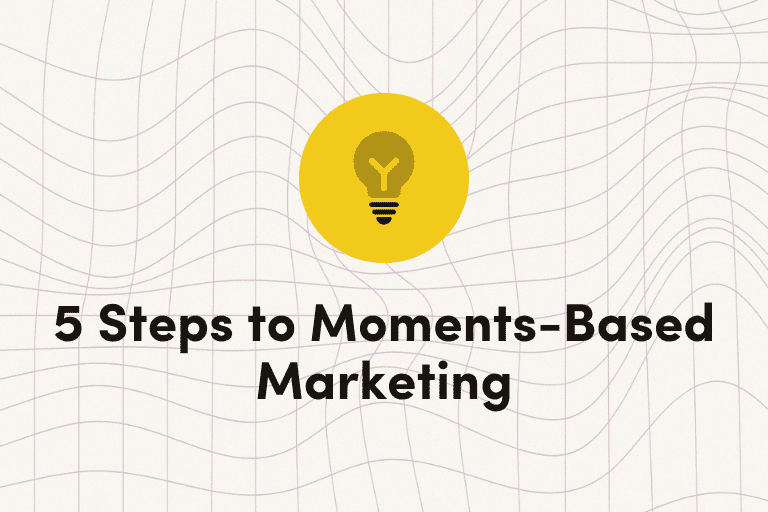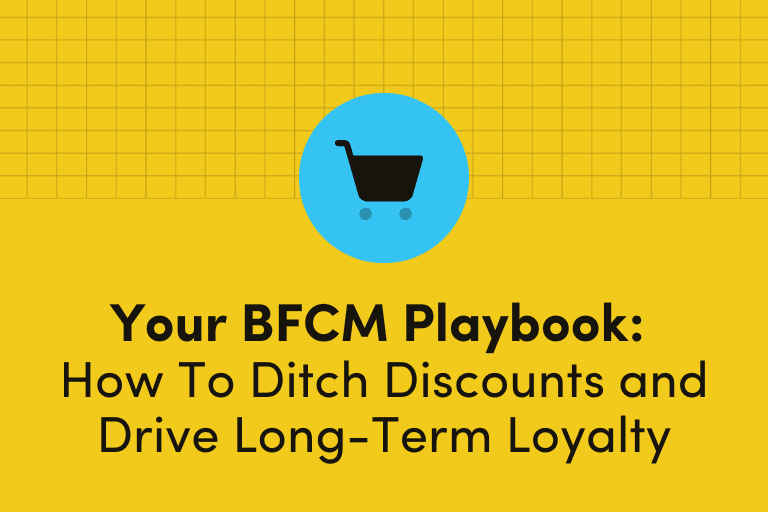Before the Thanksgiving turkey is thawed, customers are getting flooded with Black Friday and Cyber Monday (BFCM) marketing. A flurry of generic emails and ads promise 20% off here and buy-one-get-one-free there — but no one’s actually winning. Shoppers are exhausted by mid-November, and businesses duke it out over tiny profit margins.
Enough with boring discounts. This year, swap that dog-eared BFCM playbook for smarter, data-driven customer marketing. Here’s how to use AI-driven optimization tactics like segmentation and omnichannel journeys to win over more customers this holiday season — and keep them all year.
1. Focus on repeat buyers, not shiny new customers.
Traditional holiday marketing appeals to bargain hunters and people shopping for loved ones. They search until they find the best deal and then vanish. These one-time sales might make your bank account happy, but they’re not sustainable. You’ll get better results by focusing on repeat customers, who spend 67% more than new ones.
Another classic mistake is waiting until you’re defrosting your Thanksgiving turkey to launch your BFCM campaigns. In 2024, nearly half (45%) of customers started shopping in early November. If you wait until Cyber Week, you’re too late to be on their radar.
“Get in front of customers and lapsed customers before BFCM (think end of October/early November). Put the effort into personalization and re-engaging audiences sooner and teasing BFCM offers, so that when the time comes, your brand is already top of mind.”
~Kaleena Zagrzebski, Retention Marketing Lead at The Maze Group
Start by using last year’s BFCM data to reconnect with buyers before the holiday season starts. And no, a spray-and-pray “Remember us?” email won’t cut it. Here’s a rough timeline sketch out your content calendar:
- August and September: Start building segments and working on creative assets.
- October: Launch your early-bird campaigns and test them on different channels.
- Early November: Kick off pre-sale or waitlist experiences.
- Black Friday & Cyber Week: Reach all your customers with orchestrated journeys. Use data analytics to track them in real time and adjust if your messaging isn’t quite landing.
- Post-BFCM: There is no time to rest yet. Retarget browsers who never converted and upsell to recent buyers with accessories and add-ons.
Your BFCM Power Play
Instead of mass emails, Iterable lets you create dynamic audiences to auto-group these prior buyers into categories like Early-Bird Shoppers and High Spenders.
With automated journeys and historical event triggers, you can create targeted win-back campaigns for past buyers or users who show intent but haven’t purchased. This includes Product Viewers, Email Openers, and Cart Abandoners.
For even more personalization, consider user attributes like loyalty tier, purchase channel, and promo redemption history. For example, frequent buyers might appreciate an early access VIP campaign in the first week of November.
2. Follow shoppers wherever they go with omnichannel marketing.
For most customers, the internet is their playground. They’re bouncing from TikTok to their inboxes to AI search engines and back to TikTok. These adventurous omnichannel shoppers spend 1.5x more than people who stick to a single channel.
In-store shopping isn’t dead, either. Six out of ten shoppers complete their holiday buys through a combination of online and in-store shopping, with over half (51%) of them buying online and picking up in person––particularely among Gen Z and Millennials.
Despite this shift toward omnichannel behavior, not every marketing team has adapted its strategy to keep up with evolving consumer trends.
“Many brands still rely on batch-and-blast messaging and limited channels — usually just email and SMS — which leads to fatigue. Smarter teams segment by behavior and build multi-touch journeys across email, SMS, in-app, and push, using personalized content driven by data and Catalog feeds.”
~ Jon Uland, Partner, Head of Operations at Modular
Your BFCM Power Play
You don’t need to subscribe to a dozen tools to pull this off. Iterable’s centralized journey orchestration and unified customer profiles let you connect with omnichannel customers across SMS, push, email, and in-app from a single platform.
Use AI-powered features like Send Time Optimization and Channel Optimization to trigger messages based on dynamic behavioral cues rather than static calendar dates. An avid Instagram user might wander over to your website to browse products, but they’re most likely to buy when they head back to social media.
Focus on mobile-responsive messaging, too. Over 70% of holiday sales happen on mobile devices, so use SMS and Push Journeys when your customers are most likely to be scrolling. Link directly to product pages or checkout screens to cut down on the number of clicks it takes to buy.
And don’t forget to build channel fallbacks if customers don’t behave as expected. Did someone overlook your email? Try again a few days later with an SMS message.
3. Use AI to stop guessing what your customers want.
Holiday shoppers aren’t just looking for gifts—they’re looking for relevance. In fact, 71% of consumers say they expect companies to deliver personalized interactions, and 76% get frustrated when that doesn’t happen.
But at the end of the day, you’re not a mind reader…and thanks to AI, you don’t have to be. Today’s top-performing brands are using AI to cut through the noise and deliver timely, relevant experiences that feel intuitive — not intrusive. And it’s paying off: in 2024, AI-powered recommendations drove up to 15% higher conversion rates, proving that relevance, not just discounts, is what moves customers to action.
But real-time personalization isn’t just about putting a customer’s name in a subject line. It’s about tailoring product recommendations, promotions, and timing to match each shopper’s moment-to-moment intent.
“Brands today have an unprecedented opportunity to elevate their results through AI-driven, deeply meaningful, and engaging experiences that are uniquely personalized for each customer. With a solid data foundation, brands can analyze a range of useful event-based and behavioral data—think a combination of past browsing history, recent purchases, preferences, and current behavioral data—in near-real time to tailor promotions and recommendations in critical moments.”
~ Kristy LaPlante-Jodoin, Director of Marketing Technology at Bounteous
Your BFCM Power Play
Iterable gives you powerful AI features that take the guesswork out of personalization — while keeping the human touch.
Use Predictive Goals to automatically identify customers who are most likely to convert, churn, or engage. Then route them into journeys that meet their intent. For example, trigger a flash sale for your high-intent shoppers or send a win-back message to re-engage likely churners before they drift away.
Want to scale content that feels hand-crafted? Lean into Copy Assist , Snippets, and Catalog to dynamically generate messaging, product recommendations, and creative assets that adapt to each customer’s preferences and behavior.
4. Kill the discounts, keep the conversions.
For many brands, Black Friday and Cyber Monday feel synonymous with steep markdowns. But relying on heavy discounting isn’t always the smartest play. Tossing a coupon code to every cart abandoner can cut into margins and train customers to wait for deals. The truth is, it’s often not even necessary. In fact, many brands see over 10% of cart abandoners convert without any discount at all.
“Not every shopper is moved by discounts. Zero-party data helps you understand who they are and what they care about—so you can speak to them like a human, not a segment, and drive revenue without leaning on constant promotions.”
~ Blake Imperl, Senior Vice President of Marketing at Digioh
**Learn more about Iterable and Digioh’s partnership here.**
Your BFCM Power Play
With Iterable, you can capture high-intent buyers without racing to the bottom on pricing.
Create more relevant reminders by combining cart abandonment templates with Dynamic Content Blocks to automatically display the exact items left behind — including photos, real-time pricing, and inventory signals like “Only 3 left in stock!” to build urgency.
To protect the customer experience, apply suppression logic so shoppers who’ve already purchased aren’t accidentally reminded about items they’ve bought. This keeps your messaging relevant, timely, and frustration-free.
Still want to sweeten the deal with a small coupon? Use promo code personalization so that exclusive offers remain exclusive — preventing mass-sharing on forums like Facebook groups or Reddit. That way, you’re rewarding the right customers without opening the floodgates to discount abuse.
5. Measure, learn, and evolve with data-driven experiments.
Black Friday and Cyber Monday are over in a flash. With such a short, high-stakes window, you can’t afford to rely on guesswork. The brands that stand out are the ones that test, learn, and adapt in real time.
Experiment early and often — whether it’s testing subject lines, calls-to-action, or even send times. A/B tests reveal surprising insights: maybe your audience loves subject lines with three emojis, or maybe they click through more at 10:00 a.m. than at 6:00 p.m. The point is, you won’t know unless you measure and iterate. When one product sells out, swap in another. When engagement dips, adjust frequency. Every tweak you make compounds into more conversions.
“Overused tactics like generic ‘X% off everything’ blasts and endless resends to non-converters fatigue your audience fast. Smarter brands segment by lifecycle stage and lean into real-time behavior and personalization to send more relevant messages.”
~ Samantha McGrady, Senior Strategist, Email & SMS Marketing at Tinuiti
Your BFCM Power Play
Iterable makes continuous optimization simple. Use Experiments to A/B test subject lines, creative variations, or channel mixes — then automatically send winning variations to the rest of your audience for maximum impact.
Tie in performance insights to monitor what’s working (and what’s not) across all campaigns in real time. If a message isn’t landing, you can pivot fast — adjusting offers, content, or cadence.
Finally, use data feeds to automatically refresh messaging as inventory and product data change. Highlight trending products, showcase items with strong reviews, or pivot away from out-of-stock SKUs without breaking a sweat.
When time is short and competition is fierce, your best asset is agility. Measure, learn, and evolve — because every second counts.
Frequently Asked Questions about BFCM
What are the top marketing trends for BFCM?
The biggest BFCM marketing trend is the shift from one-size-fits-all discounts to personalized, data-driven engagement. Customers want relevant offers delivered in the right channel at the right moment, and brands are stepping up with smarter tools like:
- Omnichannel marketing: Shoppers are bouncing between TikTok, their inboxes, and mobile apps before making a purchase.
- Mobile marketing: Over 70% of holiday shopping now happens on mobile devices, making SMS and push notifications essential.
- AI-driven personalization: It’s no longer optional. AI-powered recommendations drive up to 15% higher conversion rates.
- Smarter segmentation is replacing batch-and-blast. Leading brands focus on both lifecycle stage and real-time behavior to send more relevant messages.
How can I improve my mobile marketing strategy for the holidays?
To optimize holiday mobile marketing, make SMS and push notifications feel relevant, timely, and seamless rather than interruptive. Test and refine send times with A/B testing or AI-powered optimization to match your audience’s habits, and use behavioral triggers like cart abandonment, price drops, or low inventory alerts instead of blasting on a schedule. Always link directly to product pages or checkout to reduce friction, and personalize with zero-party data — such as whether someone is gift shopping or self-shopping — to send more human-centered content.
What are some alternatives to offering discounts for BFCM?
Heavy discounting isn’t the only way to win during BFCM — and it can hurt your margins. Instead, consider these high-impact discount alternatives:
- Early access for VIPs. Reward loyal customers with exclusive early access to BFCM sales or product drops. This builds urgency without cutting prices.
- Limited-edition products or bundles. Create holiday-only SKUs or gift sets that shoppers can’t find any other time of year.
- Smarter reminders instead of markdowns. Many brands convert over 10% of cart abandoners without discounts simply by sending personalized reminders with images, real-time pricing, and inventory status.
Embrace Relevance, Not Deals, This Holiday Season
The Black Friday and Cyber Monday window may be short, but it can deliver outsized revenue if you play it smart. Instead of trying to out-discount your competitors, focus on creating personalized, memorable experiences that turn bargain hunters into loyal customers. With Iterable’s AI-powered personalization and omnichannel marketing tools, you’ll be ready to capture attention during BFCM — and keep shoppers engaged well into the new year.
The holiday rush is just the beginning. Get in touch to schedule a demo and learn how to keep customers engaged long after BFCM ends.

































